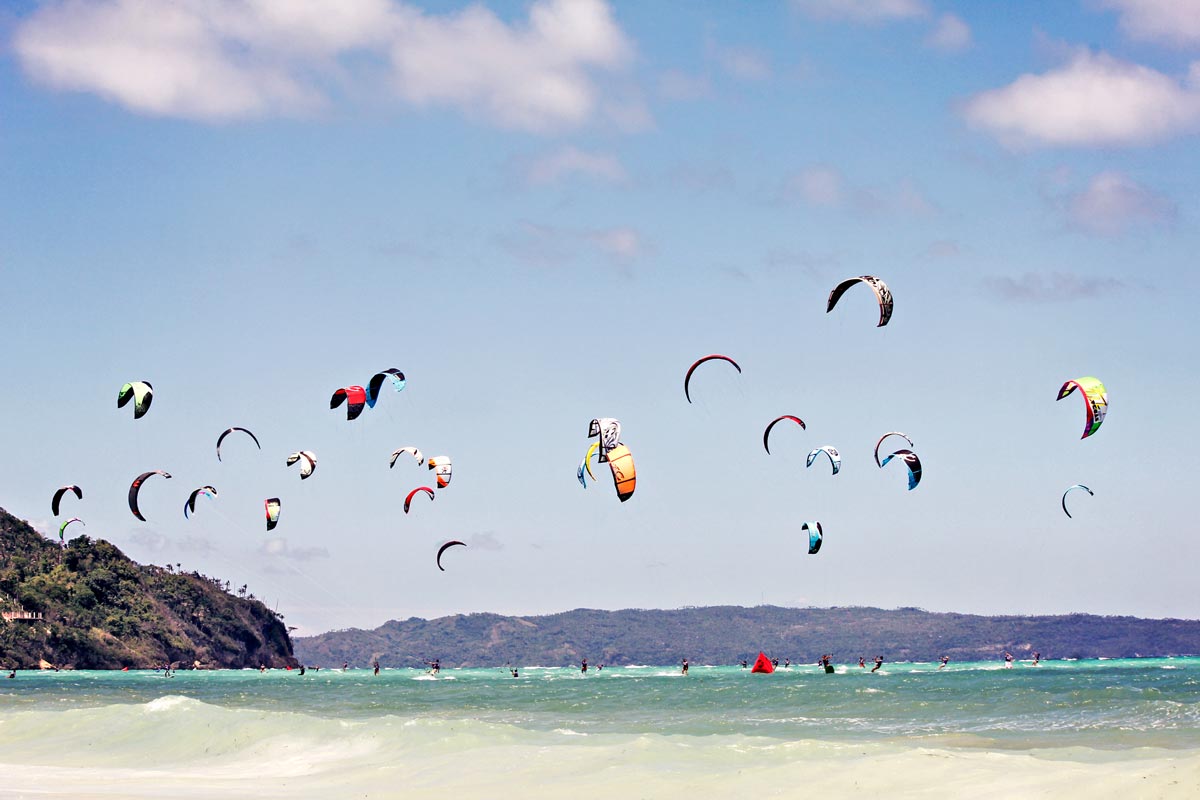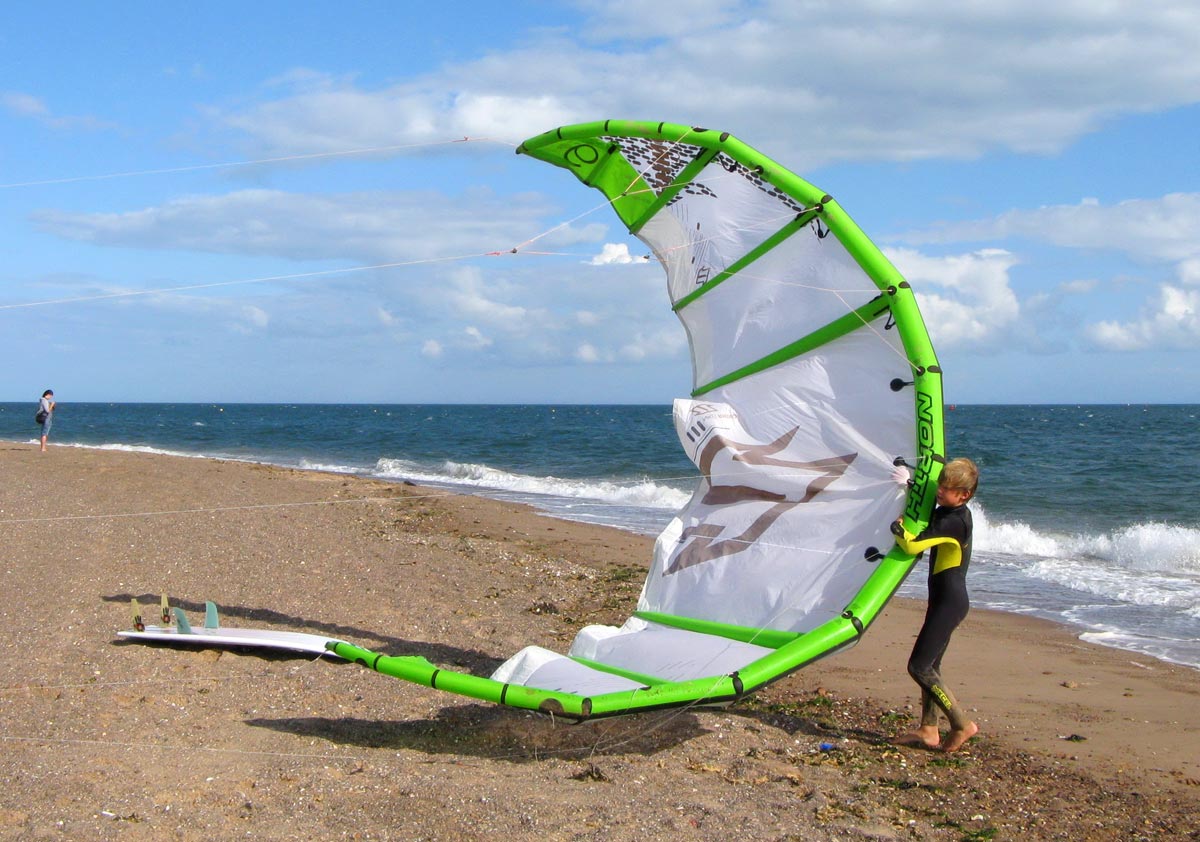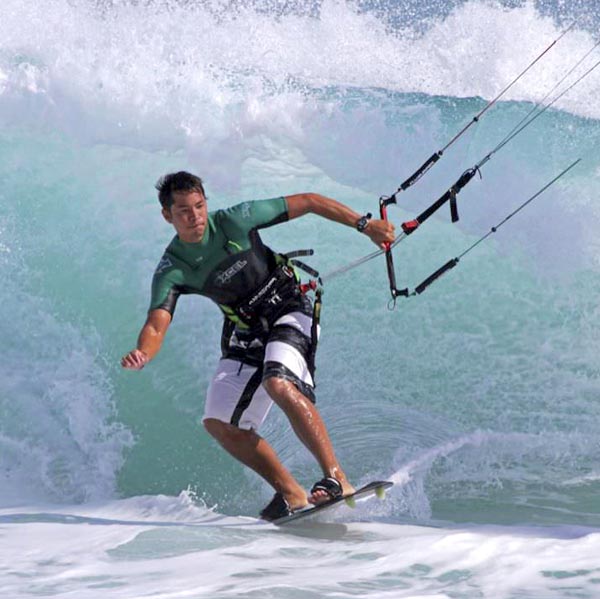Kitesurfing... 
 Invented by the French but pioneered in Hawaii, kitesurfing hit our shores around a decade ago. Pioneered by a handful of devoted followers, the sport now boasts around 500 followers in Ireland across all levels and abilities and this figure is set to grow as word spreads that this extreme water sport is possibly the best way to have fun on the water. Invented by the French but pioneered in Hawaii, kitesurfing hit our shores around a decade ago. Pioneered by a handful of devoted followers, the sport now boasts around 500 followers in Ireland across all levels and abilities and this figure is set to grow as word spreads that this extreme water sport is possibly the best way to have fun on the water.
Resembling a cross between wake boarding and parachuting, kitesurfing involves a rider being towed behind an over-sized power kite strapped to what looks like a small surf board, at speeds of up to 40 miles per hour. Besides generating speed, the power and lift of the kite enables the rider to perform breath taking jumps with acrobatic loops and spins 20 feet above the waves. A fantastic sport to watch, it’s not uncommon to see dozens of colourful kites dancing across the sky during a windy day on the beach. Participants can enjoy three to four hour sessions at sea, experimenting with a variety of the kitesurfing disciplines. If you’ve looked on with envy as the kites fly high and the riders bust some impressive moves, perhaps it’s time you got off the beach and into the water? Here’s überdog’s guide to getting started...

 There are some good websites out there to help you get a better grasp of what the sport involves. A great starting point is to hit the local forums. Check out www.nikiteforum.com. Run by local kitesurfing enthusiasts this site has a real sense of community about it and you can be sure that the guys will help you out with any initial questions you may have. There are some good websites out there to help you get a better grasp of what the sport involves. A great starting point is to hit the local forums. Check out www.nikiteforum.com. Run by local kitesurfing enthusiasts this site has a real sense of community about it and you can be sure that the guys will help you out with any initial questions you may have.
Chat to the people involved about the best places to go to watch and participate in the sport; learn who the best instructors are and where to buy the latest equipment at the best prices. From this research you’ll discover that within the sport of kitesurfing there are several different disciplines which you can experiment with. These include: Free-riding: these guys do a bit of everything Freestyle: here it’s all about ariel tricks. There are two types of freestyle: wake-style which takes it origin from wakeboarding and uses speed and tension to bust wakeboarding style tricks and ‘old school’ kitesurfing tricks - huge airs and crowd pleasing spins. Wave-riders: these guys go out in big waves and like to surf back in, using the kite to get them in and out and perform kite tricks as they go. Speed sailing: people that like to use GPS to record how fast they can go, flat water is essential for this. Course racing: sailing round buoys on a course.
Which style of kitesurfing you decide to specialise in will come down to personal choice and a basic beginners kit will give you the flexibility to try them all.

Kitesurfing is a great sport to sit and watch from the beach and Ireland has some of the best beaches in the world to view the guys in action. Top local favourites include Tyrella, Benone, Portrush and Porstewart, with the still waters of Strangford Lough at Greyabbey also proving popular. The beaches off Dingle in Ireland also rank among the best in the world.

So enough watching from the sidelines, it’s time to get involved! Firstly book yourself in for some lessons. Kitesurfing is an extremely dangerous sport and must be treated with respect. Don’t even think about taking a kite out to sea without having the proper know-how, this is the cause of many accidents and even deaths each year.
NI Kitesurfing is the only registered kitesurfing school in Northern Ireland, (there are several in Ireland - visit www.kitesurfingireland.com for details). Gary at NI Kitesurfing has years of experience teaching the sport and is now an IKO Level 2 Kiteboard Instructor and a BKSA Senior Kitesurf Instructor. There’s a lot to learn and it can take a while to feel like you’re the one in control. You’ve got to master kite control, wind conditions, board control and then you’ve got to put it all together! Lessons begin on land where you’ll be taught kite control with a smaller land kite and once you’ve mastered this you will be allowed out to sea with a more powerful water kite. Pick-up of the sport varies and depends on your instructor and how much time you get to practice in the water. A typical course is three days, at the end of which you will know how to kitesurf, but you’re unlikely to be able to get up and riding yourself without more practice. Some people will pick it up after one day and it’s a great help if you’ve flown kites before or can wakeboard. Once you’re up and riding you can decide whether you want to push yourself and compete or just participate recreationally. Next you need to think about your equipment. To get started you’ll need a board, kite, control bar for site, pump for kite, wetsuit, harness, a buoyancy aid or impact vest and a helmet. Think about whether you want to buy new or second hand. If you can afford it, the latest equipment is the best as the technology behind the equipment is evolving rapidly. A lot of companies offer great deals when you buy a bundle package. A good starter bundle kit starts at around £950. To be fully kitted out in top of the range brands will cost you about £2,000.  There aren’t really any brick and mortar shops in NI where you can try and buy, but one of the leading UK and Ireland businesses www.kitesurfwarehouse.com does have size guides online or you can arrange to visit the warehouse in Bangor to try before you buy. Failing that, if you buy and it doesn’t fit, returns are easily arranged. There aren’t really any brick and mortar shops in NI where you can try and buy, but one of the leading UK and Ireland businesses www.kitesurfwarehouse.com does have size guides online or you can arrange to visit the warehouse in Bangor to try before you buy. Failing that, if you buy and it doesn’t fit, returns are easily arranged.
Take care if you’re buying second hand off eBay as you can easily buy the wrong equipment and it’s hard to know how much use and abuse the gear has had. If you decide that this is the sport for you then you can think about joining the IKSA - Irish Kitesurfing Association or the BKSA, British Kitesurfing Association, but you don’t need to join to take a few lessons. The IKSA run competitions in Ireland so if you’re thinking of competiting you need to be a member. You also get insurance with your membership which helps cover the cost of your membership. Rules of the sport: • There needs to be enough wind - at least 15mph - people can kitesurf up to 50mph but this can be scary! • The wind needs to blowing on-shore - if it’s blowing off shore it’s too gusty. You want it blowing across-on or on-shore. For a weather report check out www.windguru.cz and www.xcweather.co.uk • Respect the dangers of the sport. Any surf kite, in the right winds has the capability to lift you 40-50 feet into the air and if you pull the bar the wrong way, you’ll be pulled down fast. It’s a very dangerous sport, but if you treat it with the right respect, use the right equipment, take lessons and listen to the right advice, you will minimise the risk of injury. • Don’t kitesurf on your own. You need someone to launch and land the kite for you and to raise the alarm if you get into trouble at sea. That said, experienced people do go out on their own, but there is a risk attached. It doesn’t take an enormous amount of strength to get started, but you’ll have some sore muscles after a session. Kitesurfing is a great sport for getting a full-body workout - from your feet to your fingers. For more information check out the following links:
n www.nikiteforum.com
n www.kiteboardingireland.com
n www.outdoorni.com
n www.kitesurf.ie
n www.iksa.ie
(Irish Kitesurfing Association)
For equipment and gear visit:
n www.kitesurfwarehouse.com
For lessons visit:
n www.nikitesurfing.com | 
![]()
![]()